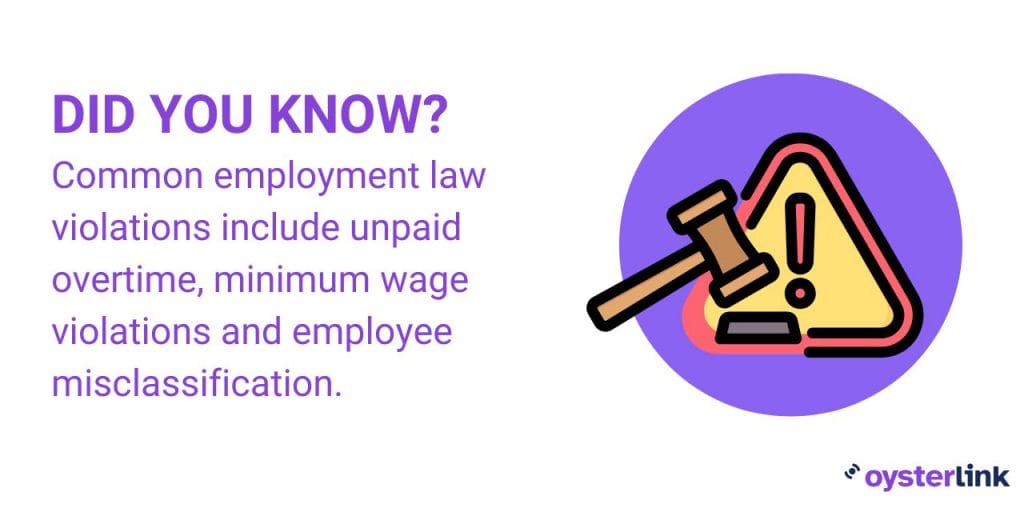This guide will walk you through hiring seasonal hotel staff, resolving common recruitment challenges and staying updated on the regulations necessary for legal compliance.
Down below you’ll also find bonus content in the form of our free recruitment process timeline, which should help you organize key tasks and identify the time required for each step in your seasonal hiring process.
What Are Some Typical Seasonal Hospitality Jobs?
A seasonal job represents temporary employment required only during certain times of the year when there’s an increase in customer demand, such as winter holidays, spring and summer breaks or even special events and festivals.
In addition to hotels, establishments like retail stores, construction companies and agricultural corporations frequently rely on seasonal workers.
We’ve listed some of the most common seasonal hospitality jobs and the reasons they may be needed.
| Job | Reason for seasonal need |
|---|---|
| Concierge | Increased guest inquiries and special requests |
| Valet | More guests requiring parking services |
| Housekeeper | Higher room turnover leading to greater cleaning needs |
| Server | Increased customer volume in dining establishments |
| Waiter | Rising demand for dining services |
| Cook | Additional meal preparation to meet service demands |
Common Challenges in Seasonal Hiring
Just like hiring for full-time roles, Recruiters also face challenges in seasonal hiring, such as finding qualified candidates, reducing the turnover rate and ensuring regulatory compliance.
Finding seasonal workers
Finding seasonal workers can be difficult due to the temporary nature of the roles. Job seekers tend to prioritize opportunities that offer benefits, stability and career growth.
Hotels can improve their chances of finding skilled workers by offering competitive wages and choosing the right platforms to post seasonal hospitality jobs.
Job boards such as LinkedIn, Monster.com and ZipRecruiter offer wide reach, user-friendly interfaces and simple application processes. That said, these platforms can be expensive especially if you’re hiring for multiple positions.
For instance, LinkedIn’s recruitment fees can reach up to $2,000, ZipRecruiter charges $24 per post and Monster.com costs $299 per month.
Why OysterLink is a better option
OysterLink is a hospitality-focused job search platform that connects you with more than 150,000 hotel and food service industry workers for FREE. It’s also optimized for mobile, helping you advertise jobs wherever you are.
Posting on an industry-specific platform like OysterLink ensures your job listings reach candidates with relevant experience and skills, resulting in faster and more efficient hiring.
Creating job descriptions
Since seasonal hiring is often done in bulk, you need to be prepared with well-written job descriptions.
OysterLink offers a library of FREE job descriptions specifically tailored for hotel and restaurant workers, available for download as PDFs or as text you can copy. This will help reduce the time spent on creating individual listings.
However, if you want to write your own job description, we also provide a detailed guide to help you get started.
Managing compliance and labor laws
Staying up-to-date with labor laws is essential since regulations can vary by state and are frequently revised.
Failing to manage compliance can lead to expensive legal disputes and damage your company’s reputation.
For example, misclassifying workers can result in significant financial penalties, as seen in the FedEx case, where the transportation company had to pay $228 million in settlements for misclassifying their drivers as independent contractors instead of employees.
Are seasonal workers independent contractors?
Just because seasonal workers are employed for only a few months doesn’t mean they qualify as independent contractors by default.
In the hospitality industry, seasonal workers may be classified as employees depending on multiple factors as determined by the U.S. Department of Labor.
How To Classify Independent Contractors Versus Employees?
| Factor | Can be an employee | Can be an independent contractor |
|---|---|---|
| Importance of the role | Performs key tasks essential to the business | May provide specialized services that are not central to the business |
| Permanency of the relationship | Long-term employment with the company | Short-term or project-based relationship |
| Investment in facilities and equipment | Uses employer-provided tools and equipment | Invests in own tools |
| Nature and degree of control by the employer | Subject to employer’s control regarding work hours, methods and quality | Operates with more autonomy and self-direction |
| Opportunities for profit and loss | Limited ability to profit or suffer losses; paid a fixed wage | Can earn profits based on performance or incur losses on investments |
| Market competition and business presence | Relies solely on employer for salary; typically doesn’t have a separate business | May seek out other clients or employers; may have a separate business |
If the above table doesn’t clarify your workers’ status, you can file Form SS-8 with the IRS to determine whether the role should be classified as an employee or an independent contractor.
To ensure you stay informed about compliance with various labor laws, check out the Wage and Hour Division (WHD) of the U.S. Department of Labor. The WHD provides extensive resources to help employers understand their responsibilities.

Reducing turnover rate
Since seasonal workers only spend a limited amount of time with an organization, they may feel less connected than full-time employees. However, there are ways to foster loyalty and reduce the seasonal turnover rate.
- Address issues promptly: Quickly resolve any problems workers encounter. Engagement drops when employees feel their concerns are ignored.
- Offer competitive pay: Since seasonal workers typically don’t receive benefits, attractive wages can motivate them to stay.
- Provide proper onboarding: Effective onboarding helps workers feel prepared and supported, enabling them to deliver better customer service and create a positive impression.
- Give regular feedback: Seasonal employees benefit from more than just task guidance. Regular feedback helps them navigate the work environment confidently.
- Create incentives for return: Offer perks like end-of-season bonuses or priority rehiring for the next season to encourage workers to return.
How To Streamline Your Seasonal Hiring Process
Here are several tips to ensure the success of your seasonal hiring.
Start planning early
Nothing’s more stressful than creating a hiring plan with only a few weeks left before the peak period begins.
Here’s a FREE TIMELINE you can download to guide your recruitment planning.
Timeline for Seasonal Hiring
4 to 5 months before the season
- Review previous data: Assess your staffing needs
- Analyze exit interviews: Address job satisfaction, training or management issues contributing to turnover
- Evaluate performance data: Identify traits of successful seasonal workers and ensure your hiring strategy aligns with them
- Review recruitment costs: Use past spending as a basis to plan your budget
3 to 4 months before the season
- Update job descriptions: Incorporate insights from your planning phase
- Standardize interview questions: Make sure you have a good mix of situational, behavioral and technical questions to assess both hard and soft skills
- Choose advertising platforms: Decide which job boards to use and whether to include social media in your mix
2 to 3 months before the season
- Post job ads and interview candidates: Start building your candidate pool
- Prepare onboarding materials: Get training content and policies ready
1 month before the season
- Finalize hiring decisions: Communicate offers to selected candidates
2 weeks before the season
- Begin onboarding and training: Introduce company policies, procedures and team members
Start of season
- Welcome seasonal workers: Conduct a formal welcome session and set expectations
- Launch operations: Start daily operations with fully trained seasonal workers
Streamline your hiring process
Along with following the timeline provided above, consider these additional tips.
- Use an Applicant Tracking System (ATS): An ATS automates resume sorting based on relevance and reduces administrative tasks.
- Standardize the interview process: OysterLink offers FREE interview questions for hospitality roles, along with whitepapers to guide your overall hiring strategy.
- Appeal to students: Seasonal work offers students a great way to make extra money without any long-term commitment. Their availability during holidays and spring breaks aligns well with peak business periods.
Provide focused training and onboarding
Since seasonal workers have limited time to adjust, it’s important to offer focused and efficient training and onboarding.
The onboarding should include online learning materials that workers can refer to any time for workplace safety, software training and company policies.
In addition, offer in-person training for proper equipment use and site tours to familiarize them with key areas (e.g. staff break rooms, parking areas for employees and storage facilities)
Finally, assign a senior full-time employee as a mentor to ensure they receive on-the-job guidance and further support new hires.
Effective training reduces mistakes, improves guest service and leaves a positive impression of your business.
Create a talent pipeline
Having a pool of reliable seasonal workers saves time and effort during future hiring cycles. Build rapport with high-performing seasonal employees by providing constructive feedback and maintaining strong relationships, so they’re more likely to return when needed.
Disadvantages of seasonal employment
Like any employment type, seasonal work has its challenges.
- Lack of skilled workers: Seasonal employment often attracts students or individuals from other industries looking to explore a new field. This makes onboarding and training crucial to ensure that new hires quickly acquire the necessary skills and knowledge to perform effectively.
- Recruitment takes a lot of effort: Seasonal hiring demands significant work — from planning and budgeting to recruitment. Following a timeline and having a skilled hiring team can help streamline the process.
- High cost: Seasonal employment can be expensive due to turnover, training expenses and compliance requirements. Mistakes from inexperienced staff can impact guest experiences, hurting your reputation and repeat business.
Common Questions Related to Seasonal Jobs
A seasonal job refers to employment that occurs during specific periods of the year. In addition to the examples provided earlier in this article, here are other positions that are also seasonal:
- Bartender
- Receptionist
- Event Coordinator
- Porter
A seasonal position can range from entry-level to skilled roles, such as lifeguards or ski instructors.
A seasonal job typically lasts for the duration of a specific season or until demand decreases.
For example, winter seasonal positions may continue throughout the ski season. On the other hand, summer jobs might extend from early summer through the fall, depending on tourism and local events.
Seasonal jobs vary in length depending on the season. Here are some typical durations.
- Winter seasonal jobs: Generally last 3 months (December to February)
- Summer seasonal jobs: Typically last 4 months (June to September)
- Spring seasonal jobs: Often last 3 months (March to May)
Holiday seasonal jobs: Usually last 1 to 2 months

Written by Rea Gierran
With a background in Communication Arts, Rea’s expertise lies in content marketing and copywriting. Her published works can be seen on online news websites such as Rappler and Adobo magazine. Outside of her work, Rea takes on the role of a “momager” for Shiro, a TikTok dogfluencer.

Reviewed by Stefan Petrov
With over 10 years of experience as a writer and editor, Stefan has worked in the automotive, IT, health and hospitality industries. Familiar with Google Search Console and other SEO tools like Ahrefs and Semrush, Stefan uses his experience to create content that’s visually appealing to the user but also ranks in the SERPs.




